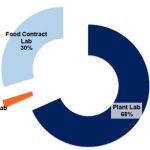The food industry is beginning to transition into an era of big data and analytics unlike anything the industry has ever experienced. However, while the evolution of big data brings excitement and the buzz of new possibilities, it also comes coupled with an element of confusion due to the lack of tools for interpretation and lack of practical applications of the newly available information.
As we step into this new era and begin to embrace these changes, we need to invest time to educate ourselves on the possibilities before us, then make informed and action-oriented decisions on how to best use big data to move food safety and quality into the next generation.
Stephanie Pollard will be presenting “The Power of Advanced NGS Technology in Routine Pathogen Testing” at the 2018 Food Safety Consortium | November 13–15One of the big questions for big data and analytics in the food safety industry is the exact origins of this new data. Next Generation Sequencing (NGS) is one new and disruptive technology that will contribute significantly to a data explosion in our industry.
NGS-based platforms offer the ability to see what was previously impossible with PCR and other technologies. These technologies generate millions of sequences simultaneously, enabling greater resolution into the microbial ecology of food and environmental surfaces.
This represents a seismic shift in the food safety world. It changes the age-old food microbiology question from: “Is this specific microbe in my sample?” to “what is the microbial makeup of my sample?”
Traditionally, microbiologists have relied on culture-based technologies to measure the microbial composition of foods and inform risk management decisions. While these techniques have been well studied and are standard practices in food safety and quality measures, they only address a small piece of a much bigger microbial puzzle. NGS-based systems allow more complete visibility into this puzzle, enabling more informed risk management decisions.
With these advances, one practical application of NGS in existing food safety management systems is in routine pathogen testing. Routine pathogen testing is a form of risk assessment that typically gives a binary presence/absence result for a target pathogen.
NGS-based platforms can enhance this output by generating more than the standard binary result through a tunable resolution approach. NGS-based platforms can be designed to be as broad, or as specific, as desired to best fit the needs of the end user.
Imagine using an NGS-based platform for your routine pathogen testing needs, but instead of limiting the information you gather to yes/no answers for a target pathogen, you also obtain additional pertinent information, including: Serotype and/or strain identification, resident/transient designation, predictive shelf-life analysis, microbiome analysis, or predictive risk assessment.
By integrating an NGS-based platform into routine pathogen testing, one can begin to build a microbial database of the production facility, which can be used to distinguish resident pathogens and/or spoilage microbes from transient ones. This information can be used to monitor and improve existing or new sanitation practices as well as provide valuable information on ingredient quality and safety.
This data can also feed directly into supplier quality assurance programs and enable more informed decisions regarding building partnerships with suppliers who offer superior products.
Similarly, by analyzing the microbiome of a food matrix, food producers can identify the presence of food spoilage microbes to inform more accurate shelf-life predictions as well as evaluate the efficacy of interventions designed to reduce those microbes from proliferating in your product (e.g. modified packaging strategies, storage conditions, or processing parameters).
Envision a technology that enables all of the aforementioned possibilities while requiring minimal disruption to integrate into existing food safety management systems. NGS-based platforms offer answers to traditional pathogen testing needs for presence/absence information, all the while providing a vast amount of additional information. Envision a future in which we step outside of our age-old approach of assessing the safety of the food that we eat via testing for the presence of a specific pathogen. Envision a future in which we raise our standards for safety and focus on finding whatever is there, without having to know in advance what to look for.
Every year we learn of new advancements that challenge the previously limited view on the different pathogens that survive and proliferate on certain food products and have been overlooked (e.g., Listeria in melons). Advanced NGS technologies allow us to break free of those associations and focus more on truly assessing the safety and quality of our products by providing a deeper understanding of the molecular makeup of our food.








